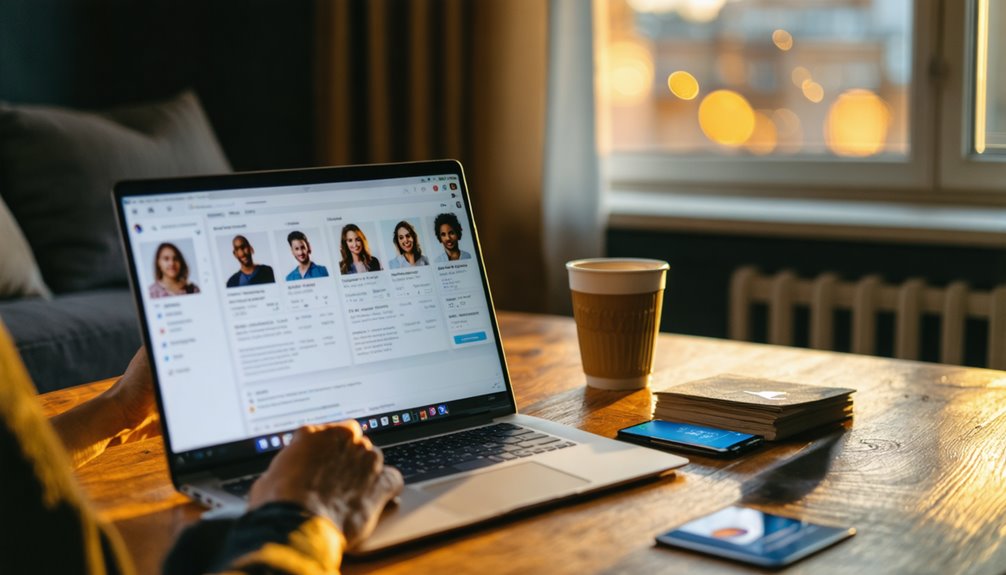Dating Sites That Do Background Checks: Safer Ways to Meet Matches

As dating apps face fraud and safety concerns, background checks are moving from niche to normal. We look at how platforms verify identities, what criminal or public records they screen, and how consent and data retention are handled. We’ll compare built‑in checks with third‑party tools, highlight privacy trade‑offs, and share practical steps to vet matches without overexposing data. We also flag red signs in chats and meetups—and where these systems still fall short.
Why Background Checks Matter in Online Dating

Although online dating has gone mainstream, safety concerns persist, and background checks have become a practical safeguard. We see platforms adopting vetting to raise trust signals and deter bad actors. For users, it’s not fearmongering; it’s risk management. We’re tracking a clear trend: when profiles are verified, reported fraud and harassment decline. Background checks also counter catfishing and romance scams that exploit privacy risks. Investors and executives cite liability reduction and brand protection as drivers. Users gain transparency without replacing personal judgment. In a crowded market, safety differentiates: stronger trust signals improve matching quality, retention, and word-of-mouth, sustaining healthier communities.
How Dating Site Background Checks Work

Let’s break down the workflow: most dating platforms start by verifying identity through document scans or live selfies, then match that to public records to confirm name, age, and location. We see providers route these checks through third-party compliance vendors, log consent, and timestamp results. Systems flag discrepancies for manual review rather than auto-rejecting accounts. To reduce bias, teams calibrate match thresholds and audit false positives. We watch user perceptions hinge on clear explanations, remediation steps, and dispute channels. Algorithm transparency matters: platforms publish verification criteria, data sources, and retention windows, and they separate safety checks from ad targeting or ranking.
What Information These Checks Typically Reveal

We’ll focus on what background checks usually surface: identity verification details, such as legal name, age, and known aliases matched against public records. We also look at criminal and safety records, including arrests, convictions, restraining orders, and sex offender registry status, subject to jurisdictional limits. Expect variations by data source and partner vendor, which affects coverage, update speed, and accuracy.
Identity Verification Details
From basic ID matching to device forensics, identity checks on dating platforms typically verify a user’s legal name, date of birth, and photo likeness against a government-issued ID, then corroborate that data with signals like phone number ownership, email domain age, IP/geolocation consistency, and device fingerprint. We see providers layering photo verification with biometric screening to reduce spoofing and bots, while social verification links profiles to established networks for added trust. Vendors report declining fraud when logins, devices, and IDs align within risk thresholds.
| Check Type | Data Points | Purpose |
|---|---|---|
| Government ID | Name, DOB, ID number | Core identity |
| Biometric screening | Selfie, liveness | Match likeness |
| Social verification | Handles, network age | Authenticity signals |
Criminal and Safety Records
With identity anchored by IDs, biometrics, and device signals, platforms then screen for criminal and safety red flags that could affect user risk. We typically see checks pull felony and misdemeanor convictions, active warrants, restraining orders, sex‑offender registrations, and domestic violence records. Some systems add arrest histories, but policies vary by state. We also note exclusions: expungements, record sealing outcomes, and most juvenile offenses usually don’t appear. Platforms may surface civil protection orders and recent incarceration data, plus terrorism and sanctions lists. Time windows matter—many providers cap lookbacks at seven years. We advise users to read methodology and dispute procedures.
Privacy Considerations and Legal Limits
Although background checks can enhance user safety, we have to balance that promise against strict privacy expectations and legal boundaries. We should collect only what’s necessary—data minimization—to reduce exposure and comply with consent rules. Users deserve clear notices about what’s checked, why, and how long it’s retained. We need auditable processes for access controls, deletion, and dispute resolution.
Jurisdictional differences shape what’s lawful to verify and share. In the EU, GDPR limits profiling and mandates lawful bases; in the U.S., FCRA may apply when reports inform eligibility-like decisions. We should avoid sensitive data unless explicitly required and document proportionality assessments.
Popular Dating Platforms Offering Background Screening
Against a backdrop of rising safety expectations, several mainstream dating apps now integrate optional background screening through vetted partners. We’re seeing platforms pilot checks tied to identity verification, with clear disclosures and opt-in consent. Bumble and Tinder highlight in-app pathways to screen dates, while Match brands the capability as part of broader Safety features like reporting prompts and photo verification. Hinge tests similar flows. Costs vary, results don’t equal endorsements, and appeals exist. User reviews note peace of mind but ask for transparency on data sources and accuracy. We recommend reviewing eligibility criteria, false-positive policies, and how platforms handle disputed records.
Third-Party Services You Can Use Yourself
Some daters prefer to run their own checks rather than rely solely on app-based tools, and a growing market of third-party services makes that possible. We can combine basic identifiers with public records to confirm names, locations, or red flags. These platforms typically aggregate court filings, address history, and social media links; some offer reverse phone lookups and email intel. Pricing varies, so we should weigh report depth against speed and transparency.
- Reverse phone search tied to carrier data and spam indicators
- Public records aggregators for court and address history
- Email intelligence with breach and alias flags
- Social media correlation engines
- Identity-resolution tools connecting fragmented profiles
Tips for Verifying Matches Beyond the App
Before we move off-platform, we can layer simple checks to validate identity and intent. We start with meet verification: request a quick video call, confirm live likeness, and reference a recent detail from chat. We compare names, handles, and workplace listings across LinkedIn and other professional directories. We ask for mutual disclosures—general location, first name spelling, and a non-sensitive social link—and reciprocate proportionally.
We validate photos via reverse image searches and metadata cues. We suggest exchanging a short voice note to confirm cadence and accent consistency. We schedule logistics through a fresh text thread, confirming date, time, and venue, while preserving minimal, necessary data sharing.
Red Flags to Watch For When Chatting and Meeting
While most matches behave normally, we flag patterns that correlate with scams, misrepresentation, or coercion. We’ve tracked recurring signals that reliably predict elevated risk during chats and first meetings. These aren’t one-offs; they cluster in fraud reports and moderator escalations. When we see sudden urgency, pressure to move off-platform, or inconsistent stories, we slow down, verify, and document.
- Requests for money, gift cards, or crypto after rapid intimacy-building
- Sudden urgency to meet privately or travel, bypassing public plans
- Inconsistent stories about work, location, or timelines
- Reluctance to video chat or provide recent, verifiable photos
- Aggressive boundary-pushing, guilt tactics, or secrecy demands
Balancing Safety With Respect and Open Communication
As we balance safety with courtesy, we should get explicit consent before any background check and explain why it matters. We set expectations early by sharing boundaries on messaging cadence, verification steps, and first-meet logistics. We also address privacy directly—what we’re comfortable sharing, what stays off-limits, and how both parties can store or delete sensitive info.
Consent Before Checks
Although safety features are advancing fast, we should treat background checks as opt-in and transparent. We’re seeing platforms align with consent culture and require informed agreement before any screening. That approach protects autonomy, reduces bias claims, and strengthens trust. We recommend clear prompts, reversible choices, and auditable logs so users know what’s checked and why.
- State the purpose, scope, and data sources before requesting consent.
- Offer granular options: identity, criminal, or none.
- Provide countersigned, time-limited authorizations and easy revocation.
- Share plain-language summaries plus dispute channels.
- Log consent events and notify on every status change.
This clarity supports safety without coercion.
Share Boundaries Early
Often the safest matches start with explicit boundary-setting from both sides. We see stronger outcomes when we set expectations in our profiles and first messages: communication cadence, meet-up timelines, and comfort zones for early interactions. Clear norms reduce friction and signal accountability. We also establish dealbreakers upfront—no late-night drop-ins, no pressure to share personal details beyond what’s needed to coordinate. Platforms report fewer disputes when users outline limits early. We recommend scripting a brief boundary note and repeating it before any shift, like moving from app chat to a meeting. It’s pragmatic, respects autonomy, and keeps momentum without misunderstandings.
Discuss Privacy Openly
Routinely, we put privacy on the table early so both sides know what’s collected, what’s shared, and why. In a marketplace where background checks are standard, we set honest expectations and insist on data transparency. We state what we’ll disclose, where it goes, and how long it’s retained. We also confirm opt-outs and limits before matching, keeping consent granular and revocable.
- Identify the platform’s data flows and third-party processors.
- Specify what a check includes and excludes.
- Confirm retention periods and deletion pathways.
- Use in-app channels; avoid sharing IDs via chat.
- Document consent updates and notify on policy changes.
Conclusion
We’ve seen background checks evolve into practical safety tools for modern dating. When platforms pair identity verification with transparent consent, limited data retention, and clear dispute paths, we minimize fraud and risky encounters without over-collecting data. Leading apps and third‑party services now offer layered screening, while in‑app messaging and boundary‑setting keep control in our hands. Combine these checks with independent verification, watch for red flags, and communicate openly. That balance delivers safer connections—and more confidence—before we meet.
